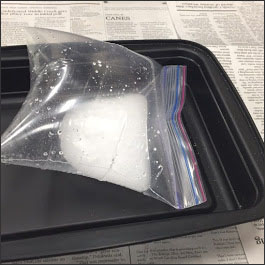Explode-A-Bag

Materials:
Prepare for 6 Groups
- Pans or Bowls
- Baking Soda Pouches (1 rounded tbsp baking soda, in a piece of single ply toilet paper)
- 1 quart vinegar (1/4 cup or 75mL per group)
- 1/3 cup measuring cups or 25mL graduated cylinders
- Ziploc sandwich bags
Instructions:
- To make baking soda pouch (prep ahead or have one teammate do this – Teammate #5, depending on age group): Measure 1 rounded tablespoon of baking soda into a square of single ply toilet paper. Fold horizontally and secure with a small piece of tape, then fold vertically and wrap it all the way around with a large piece of tape, ensuring it will stay closed. Make 1 per group.
- Break students into 4-6 groups, ideally 4 to a group so everyone has a job, depending on class size.
- 1 pan/bowl
- 1 sandwich bag
- 1/3 cup measuring cup or 25mL graduated cylinder
- 1 baking soda pouch
- Vinegar
- Teammate #1 is bag security guard. This person is in charge on holding the sandwich bag and opening and closing it when needed. (Demonstrate how to open bag only half way and close by sliding fingers across to ensure it is completely sealed)
- Teammate #2 measures 1/3 cup or 75mL vinegar. #1 should open bag, #2 pour in vinegar, then #1 practice closing bag so it cannot spill
- Teammate #3 is in charge of the baking soda pouch. Explain all directions first before adding pouches, as reaction is fast. *Have students wear goggles for this step if available.*
- Open bag slightly, allow empty portion to hang over edge of pan and add baking soda pouch so that it does not touch vinegar
- #1 zip bag shut without mixing chemical yet
- Teammate #4 lift bag, allowing chemicals to mix. Shake 3 times, place in pan/bowl and observe what happens!
VIDEO COMING SOON BUT YOU CAN STILL ENJOY THESE AWESOME EXPERIMENTS!
How It Works:
When the baking soda and vinegar mix, it results in a chemical reaction that produces carbon dioxide (CO2) along with water (H2O) and sodium acetate. If the bag is properly sealed, the carbon dioxide is trapped and fills the bag until it cannot hold any more, at which point it pops!
EXPLORE TONS OF FUN AND EASY SCIENCE EXPERIMENTS!
SUBSCRIBE AND NEVER MISS A NEW SCIENCE FUN VIDEO!

